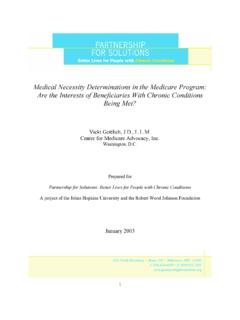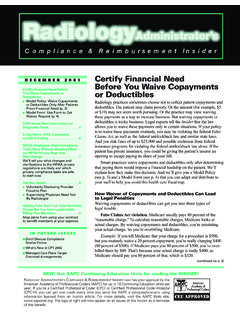Transcription of Care Coordination for People with Chronic …
1 care Coordination for People with Chronic Conditions By Robert L. Mollica Jennifer Gillespie National Academy for State Health Policy Portland, ME Prepared for: Partnership for Solutions Johns Hopkins University January 2003 Contents Executive Overview of Chronic Conditions and Implications for the Health Why Coordinate care for People with Chronic Conditions?..4 Models for Coordinating Medical and Supportive Social models ..5 Medical models ..7 Integrated Discussion of State care Coordination Appendix: Summaries of Selected State care Coordination Maine.
2 26 Massachusetts ..28 New Hampshire ..30 Vermont ..32 1 EXECUTIVE SUMMARY The number of Americans with one or more Chronic conditions is expected to increase from 125 million in 2000 to 157 million by 2020, and the number of People with multiple Chronic conditions will rise from 60 million to 81 million. A Chronic condition is one that is likely to last more than one year, limits a person s activities, and may require ongoing medical care (Partnership for Solutions, forthcoming chartbook). People with multiple Chronic conditions typically receive health and home care services from different systems, often from multiple providers within each system.
3 As a result, the health care delivery system for those with Chronic conditions is complex and confusing, and care is often fragmented, less effective, and more costly. States are seeking to develop and sustain integrated care Coordination models that help ensure that services are consistent with the complex needs of beneficiaries and that providers are aware of the services received from other parts of the health and long-term care systems. States are also interested in controlling Medicaid spending. care for People with Chronic conditions accounts for 77 percent of Medicaid spending for beneficiaries living in the community.
4 Eleven million, or nine percent, of the People with Chronic conditions rely on Medicaid for coverage, and two and a half million, two percent, are dually eligible for Medicaid and Medicare. The average per capita health care expenditure is significantly higher for individuals with one or more Chronic conditions than for those with no Chronic conditions. Among the Medicaid population, the costs are more than double, and for People age 65 and older who are dually eligible for Medicare and Medicaid, costs are more than five times higher. care Coordination for People with Chronic conditions who participate in what has come to be known as the social model of home and community-based service programs (including Coordination in subsidized elderly housing sites) has been narrowly focused on supportive services.
5 At the same time, a medical model of care Coordination has begun to emerge in the fee-for-service health care system and in managed care programs. As these care Coordination efforts develop, there seems to be increasing recognition that a gap between supportive and medical services exists and needs to be addressed; a hybrid or integrated model is beginning to emerge. This paper explores the components of care Coordination and a sample of state initiatives that bridge the health and supportive services systems. A literature review found many variations among organizations providing care Coordination for People with Chronic conditions.
6 While it is not known how many community-based, single entry systems are developing linkages to primary care providers and other health services, the literature review revealed a number of demonstration programs that have the potential for broader replication. While this paper includes some description of the development of care Coordination in health plans, it is primarily focused on state initiatives involving public programs such as Medicaid. State strategies can be arrayed along a continuum with five categories: social, social/medical, medical, partial integration, and full integration.
7 2 Social models focus primarily on supportive needs and have limited collaboration with primary care physicians; The social/medical model develops closer working relationships between health and supportive services systems, sometimes through the location of social services care coordinators in physician offices, but does not include the authority to authorize services of both systems in one agency; Medical models coordinate services through disease management programs, serving beneficiaries with a specific diagnosis, and primary care case management services for beneficiaries with complex social and medical conditions that place them at high risk of hospitalization and adverse outcomes; Partially integrated models allow the organization to authorize Medicaid medical and supportive services; and Fully integrated models include all Medicaid and Medicare medical and supportive services.
8 Models can be compared based on the setting in which care Coordination occurs, the scope of authority for managing services, and the relationship between long-term care services and health services. State strategies for bridging the long-term care and health systems for the majority of low-income People with Chronic conditions could be informed by convening state policy leaders, advocates, and stakeholders. These forums could enable participants to review barriers to care Coordination , identify promising program models, and discuss possible reforms and initiatives that states could embrace to better serve the chronically ill.
9 3 OVERVIEW OF Chronic CONDITIONS AND IMPLICATIONS FOR THE HEALTH care SYSTEM As the nation makes significant advances in the treatment of Chronic conditions and the expansion of supportive services to maintain the independence of People with functional limitations, navigating and accessing services has become more complex. The Partnership for Solutions has issued a series of profiles describing People with Chronic conditions (2002a,b,c,d,e). Among its findings: An estimated 125 million Americans had at least one Chronic condition in 2000, and the prevalence of Chronic conditions is projected to increase to 157 million Americans by 2020.
10 In 2000, 60 million Americans had multiple Chronic conditions, and by 2020, a projected 81 million People will have multiple conditions. The prevalence of multiple Chronic conditions increases with age. Among People age 65 and older, 62 percent have two or more Chronic conditions. By age 80 and older, 70 percent have two or more Chronic conditions. For purposes of this paper, a Chronic condition is defined as one that is likely to last more than one year, limits a person s activities, and may require ongoing medical care (Partnership for Solutions, 2002 e).






